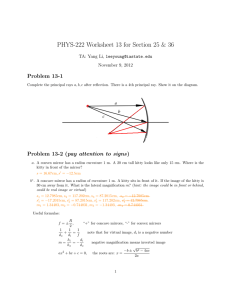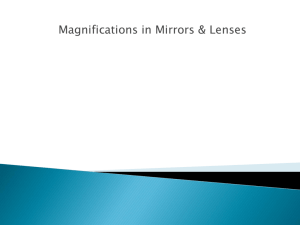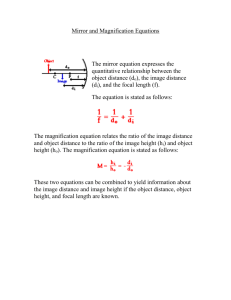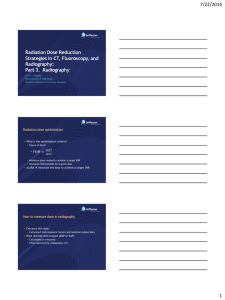Physics of Computed Radiography Computed Radiography (CR) Photostimulable Storage Phosphor
advertisement
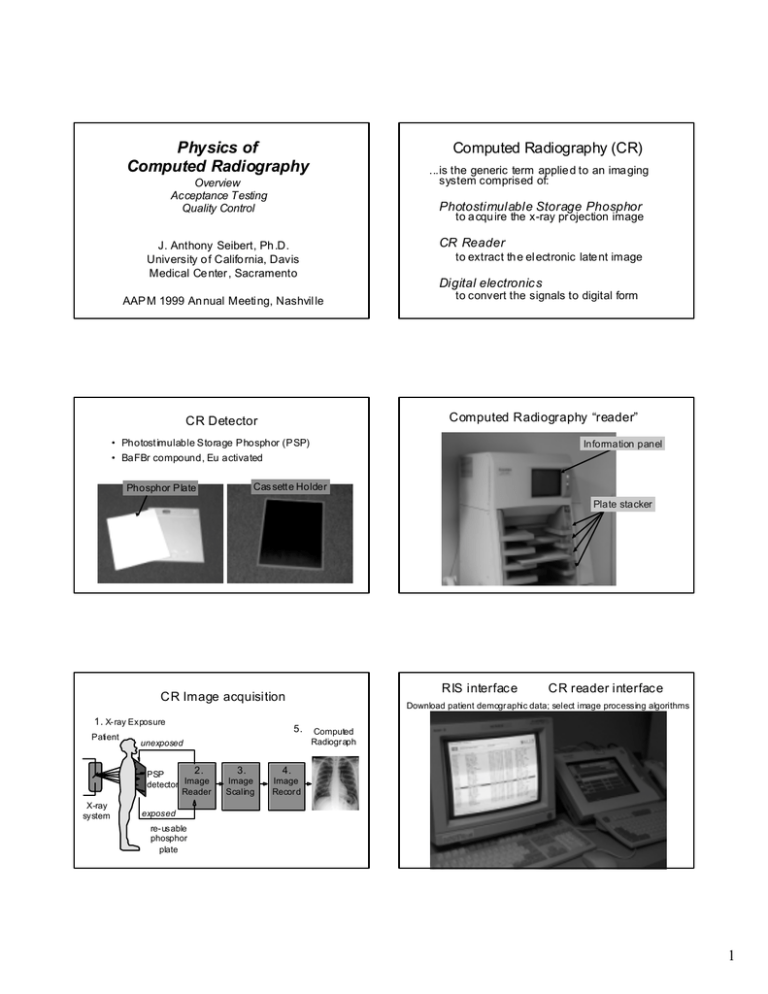
Physics of Computed Radiography Computed Radiography (CR) ...is the generic term applie d to an ima ging system comprised of: Overview Acceptance Testing Quality Control Photostimulable Storage Phosphor to a cqu ire the x-ray pr ojection image CR Reader J. Anthony Seibert, Ph .D. University o f Califo rnia, Davis Medical Ce nter , Sacramento to extract th e el ectronic late nt image Digital electronics AAP M 1999 An nual Meeti ng, Nashvil le to convert the signals to digital form CR Detector Computed Radiography “reader” • Photostimulable Storage Phosphor (PSP) • BaFBr compound, Eu activated Information panel Cas sette Holder Phosphor Plate Plate stacker RIS interface CR Image acquisition 1. X-ray Exposure Patient X-ray system 5. unexposed 2. PSP detector Image Reader CR reader interface Download patient demographic data; select image processing algorithms 3. 4. Image Scaling Image Record Computed Radiograph exposed re-usable phosphor plate 1 ID terminal: select anatomy-specific exam Bar-code reader: identify exposed cassette Film laser printer CR Networking CR Reader • DICOM – Digital Imaging COmmunications in Medicine – Provides open architecture solutions for modality interfaces, storage/retrieval, and print functions Dicom CR - QC Workstation • Technologist QC Workstation • Modality Worklist Input • Processed image output Soft-cop y review CR vendors CR Trends • Fuji ........ (GE, Siemens, Philips, others ) • Lower system costs • Agfa ........ (Toshiba) • Smaller footprint • Kodak • High throughput sy stems • Konica • Low throughput systems “Table-top” units • Lumisys • Integrated QC workstations for images • Others • DICOM output 2 Digital x-ray detector Conventional film/screen detector 1. A cqu isition, Display, Ar chiving 1. A cqu isition Transmitted x-rays through patient 2. Display Transmitted x-rays through patient Film processing: Digital processing light to optical density Gray Scale encoded on film Intensifying Screens x-rays → light Film An al og to Di gi tal C on ve rsio n 3. A rchi ving Stimulation and Emission Spectra Electrons trapped in proportion to x-rays absorbed 3.0 eV e- F/ F + τ =Eu Eu3+ / Eu 2+ Incident x-rays e- e- Laser stimulation 2.0 eV 8.3 eV Valence band F centers proportional to incident x-ray intensity Relative intensity PSL τ =recombination Di od e 68 0 nm 0.0 80 0 He Ne 63 3 nm 70 0 1.5 60 0 1.75 2 50 0 2.5 λ (n m) 40 0 30 0 3 4 Ene rgy (eV) CR: Latent Image Readout Referen ce detector Light guide Emi ssion 0.5 Photostimulated Luminescence Incident Laser Beam BaFBr: Eu2+ Stimu latio n 1.0 Conduction band τtunneling = X-ray converter x-rays → electrons Charge collection device PSP Latent Image Formation ph on on D ig ital to An al og C on ve rsio n Digital Pixel Matrix PSL Signal PMT f-θ le ns Lase r Source Polyg onal Mirror Cyli ndrica l mi rror Li ght cha nnel ing gu ide Output Signal ADC Exposed Imaging Plate Light Scattering Photostimulated Luminescence Protective Layer Laser beam: Sca n direction To i mage proce sso r Phosphor Layer Las er Light Spr ead "Effective " read out di amete r Base Support PMT Plat e translation: Sub-scan direction 3 Phosphor Plate Cycle PSP Base support x-ray exposure Sub -scan Direction plate exposure: create latent image Plate translation reuse laser beam scan Typic al resolution: plate readout: extract latent image 35 x 43 cm -- 2.5 lp/mm 24 x 30 cm -- 3.3 lp/mm 18 x 24 cm -- 5.0 lp/mm light erasure plate erasure: remove residuals Scan Direction Laser beam deflection Characteristic Curve: CR Image Manipulation response of screen/film and CR • Contrast enhancement – Anatomy specific grayscale manipulation • Spatial frequency enhancement Finding the Image Location • Image recognition phase 10 ,0 00 4 Film Optical D ensity – Find the pertinent image information – Scale the data to appropriate range Film -screen (40 0 spe ed) 3 CR pla te 1,00 0 Ove rexposed 2 10 0 Corre ctly expo se d 10 1 Und erexpose d 0 0.01 0.1 1 10 10 0 1 Exp osure , mR 20 00 0 20 00 20 0 20 2 Sen sitivi ty (S) Rel ative intensi ty of PSL • Image pre-processing Collimation area(s) determined Collimation Border – collimation (Agfa) – EDR (Fuji) – segmentation (Kodak) • Finding collimation borders and edges 4 Processing the Image Histogram analysis • Contrast enhancement • Frequenc y distribution of pixel values within a defined area in the image – MUSIC A (Agfa) – Gradation (Fuji) – Tonescaling (Kodak) • Shape is anatomy specific • Define dynamic range (histogram analysis) • Sets minimum and maximum “useful” pixel values • Transform to anatomy specific contrast Data conversion Histogram Distribution Open area Frequency Pixel value Useful signal Input to outpu t dig ita l number 1,000 Re la ti ve PSL Anatomy Output dig ital number Collimated area Grayscale transformation Exposure into digital number 102 101 100 10-1 10-1 100 101 102 103 0 511 1023 Exp osure input Raw Digital Outp ut 800 600 400 200 0 200 600 1,000 Raw Input d igital numbe r Histogram mi n The shape is dependent on radiographic study, positioning and technique max 1. Find the signal 2. Scale to range 3. Create film look-alike Histogram: pediatric image to 9 368 to 8 323 Frequency 800 600 400 200 0 0 200 400 600 800 100 0 Useful image range for anatomy Di gital valu e Pre-processed no window/level Contrast enhanced 5 Data conversion for overexposure Data conversion for wide latitude Exposure into digital number Exposure into digital number Incre ase gr adi ent 1 02 1 02 Rel ative PSL Re la ti ve PSL Re du ce gai n 1 01 1 00 1 0- 1 Exposure in put 10 -1 10 0 10 1 10 2 10 3 0 51 1 10 23 Ra w Di gital Ou tp ut overexposure min max (sca led a nd l og am pli fi ed) 1 01 1 00 1 0- 1 Exposure in put 10 -1 10 0 10 1 10 2 10 3 high kVp (w ide latitude) 80 kVp, 18 mAs 400 speed screen - film 10 23 (sca led a nd l og am pli fi ed) min max Computed Radiography Overexposed Screen- Film 80 kVp, 18 mAs 51 1 Ra w Di gital Ou tp ut Screen-F ilm Underexposed 0 Underexposed Overexposed CR 80 kVp, 18 mAs L=4, wide latitude 6 CR: Contrast Enhancement Look-up-table transformation Output digital number 1,000 M L E A 800 Fuji System 600 Example LUTs 400 200 0 0 200 400 600 1,000 800 Input digital number “Raw data” Spatial Frequency Processing “Contrast Enhanc ed” CR: Image manipulation • “Edge Enhancement” Di fference : Edge Enh anced: Dash : l ow pass fi ltered Ori gin al - filtered Di fference + Origin al Response Soli d: orig inal resp onse Sum lo w hi gh lo w hi gh lo w hi gh Spatial frequency “Black Bone” CR: Dual Energy Imaging Low Energy Image High Energy Image “Edge Enhanced” CR: Dual Energy Imaging “Tissue only” Image “Bone only” Image 7 CR: Spatial Resolution Image Performance Measures • Pho sph or p late sizes: impact on resolution • Spatial res olution – Dependent on IP size – Less than corresponding speed screen-film • Contrast sensitivity – Dependent on exposure and SNR • Exposure – Variable speed detector 35x43 (14x17) 24x30 (10x12) 18x24 (8x10) 0.2 mm pixels 0.14 mm pixels 0.1 mm pixels High Contrast (Spatial) Resolution 18 x 24 cm MTF Curves 35 x 43 cm 1.0 0.8 Pre-sampled MT F MTF Screen-film Scan 0.6 Subscan Hi res CR 0.4 Sampled MT F: Standard CR 2K x 2K matrix 35 x 43 cm Standard CR 0.2 0 Photon absorption fraction 10 Low Contrast Response: Leeds TO -16 X-ray Absorption Efficiency 1 2 4 6 8 Spatial F requency (lp/mm) BaFBr, 100 mg/cm² 0.8 Gd 2O2S, 120 mg/cm 2 0.6 0.4 BaFBr, 50 mg/cm² 0.2 0 0 20 40 60 80 Energy (keV) 100 120 140 3.5 mR 70 kVp 0.5 mR 8 Image retake rates Retake rate evaluation -- 1st half, 1992 7 Screen-Fil m 6 Wrong exam 5% Motion 6% CR 5 4 Positioning 46% Reprinting 9% 3 Under exposure 10% 2 1 0 Jan Feb Mar Apr May O verexposure 12% Jun Total # repeats = 1043 from Willis, RSNA 1996 Adu lt portable chest ca lcu lated exposures Adu lt portable chest ca lcu lated exposures First half, 1994, 4572 exams Second half, 1994, 4661 exams 38.3% 60 0 5 3.9 % 7.8% Target expo sure rang e 60 0 50 0 7 3.5 % 3.4% Target expo sure rang e 50 0 40 0 <50 10 0 20 0 0 30 0 10 0 0 40 0 10 0 50 0 Q4 20 0 System speed (S #) Low Incident Exposure <50 20 0 Q3 30 0 10 0 Q2 20 0 30 0 30 0 Q1 40 0 40 0 #exams #exams 23.1% 50 0 Percent error Repeated Examinations with CR Other 12% System speed (S #) High Low Incident Exposure High Guidelines for QC based on Exposure, typical adult exam Apri l 1 - 17, 1996 Adul t Po rtabl e Ch est Sys tem s peed 160 140 120 100 80 Grid tec hnique without a grid 60 40 0 60 0 00 -6 50 9 9 054 9 40 04 35 4 9 03 30 7 4 032 4 25 02 20 7 4 02 15 2 4 017 4 10 012 4 50 -7 4 20 0 >1 Number of examinations “Exposure Creep” 180 Sensitivi ty number Indication • >1000 <0.2 mR • Underexposed: repeat • 600 - 1000 0.3-0.2 mR • Underexposed: QC exception • 300 - 600 1.0-0.3 mR • Underexposed: QC review • 150 - 300 1.3-1.0 mR • Acceptable range • 75 -150 1.3-2.7 mR • Overexposed: QC review • 50 - 74 4.0-2.7 mR • Overexposed: QC exception • <50 >4.0 mR • Overexposed: repeat 9 New issues for the Medical Physicist: Digital Projection Imaging Radiation Dose for CR • Variable Speed Detector • Differences between screen-film and PSP detectors • Optimal dos e 2X higher than 400 speed screen/film – Lower absorption efficiency • Testing digital systems: vendor specific details • Indirect (CR) vs. direct (Flat-panel) detectors – Quantum and electronic noise • Exposure levels and SNR measurements – Readout inefficiencies of latent image • QC phantoms • Anti-scatter grids needed • Soft-copy displays and workstations Uniformity Recommended acceptance tests (Ta sk Group #10 -- AAPM) 498 508 537 480 • Physical Ins pection - Inventory • Evaluation of image process ing parameters 490 513 • Imaging Plate Uniformity and Dark Noise • Signal Response – Linearity and Slope – Calibration and Beam Quality 497 505 544 487 • Laser Beam Function CR Parameter Settings Demographics on Fuji CR output Fu ji CR reader system Ex po su re m e nu c ode R ea d out (ED R) m ode A - Auto m a tic S - S e m i-a utom a t ic F - Fix e d U CD MC RA DIO LO G Y 00 A 0200 Top of film Film Imag e D ATE PO R TAB LE C HE ST L 2 .0 S 2 5 0 C *1 .6 , *1 .0 G 1 .0 E # 1 .0 -- 0 .2 0 R 0 .3 A 054 # 9 5 0 3 3 10 5 4 1 1 :4 5 B ottom 2 /3 of film L = La tit ude (us e ful r an ge of e x pos ur es in o rde rs of m a gnitude ) S = S e ns itiv ity (v a lue inv e rs e ly re la te d to inc ide nt e x pos ur e ) C = De ns ity / c ontr a s t s e tting m od ific a tions G = Film ga m m a c ur ve s e tt ings (c ontr a st e nha nc e m e nt pa r am et e rs ) No te : the a s s oc ia te d le tte r s in dic a te the LU T ty pe R = Fre que nc y pr oc e s sin g (s pa tia l a nd e dge e nh an c em en t pa ra m e te r s ) A = Num be r of film s s inc e la s t re bo ot of s y s te m 2 /3 = Im a ge re duc t ion fa c tor ( 6 7 % of a c tua l s iz e in this c a s e ) R= m I a ge re v e rs a l indic a tor Tim e 0 3 .3 1 .1 9 95 Pa tie nt Ide ntific a tion R Anatomical region Gener al ch est (LAT) Gener al ch est (PA) Port Chest GRID Port Chest NO GRI D Peds chest NICU/PICU Finger Wrist For earm Plaste r cast (ar m) Elbo w* Upper Ribs* Pelvis* Pelvis por table Tib/F b i Foo t Foo t* Os Calcis Foo t cast C-spine T- sp n i e Swimme rs Lumba r spine Breast specimen GA 1.0 0.6 0.8 1.0 1.1 0.9 0.8 0.8 0.8 0.8 0.8 0.9 0.9 0.9 0.8 1.2 0.8 0.8 1.1 0.8 1.2 1.0 2.5 GT B D F D D O O O O O O O O N O N O O F F J N D GC 1.6 1.6 1.8 1.6 1.6 0.6 0.6 0.6 0.6 0.6 1.6 0.6 0.6 0.6 0.6 0.6 0.6 0.6 0.6 1.8 0.9 0.9 0.6 GS -0.2 -0.5 -0.0 5 -0.1 5 -0.2 0.3 0.2 0.3 0.4 0.4 0.0 0.2 0.2 0.25 0.3 -0.0 5 0.4 0.5 0.5 -0.0 5 0.3 0.4 0.35 RN 4.0 4.0 4.0 4.0 3.0 5.0 5.0 5.0 5.0 7.0 5.0 6.0 4.0 5.0 5.0 7.0 5.0 5.0 5.0 4.0 5.0 5.0 9.0 RT R R T R R T T T T T R T T F T T F F P T T T P RE 0.2 0.2 0.2 0.5 0.5 0.5 0.5 0.5 0.5 1.0 1.0 1.0 0.5 0.5 0.5 0.5 1.0 0.5 0.5 0.2 0.5 1.0 1.0 10 Da te: 7/1 0/98 M ed ci al Phy si ci st: Antho ny Sei be rt, Ph.D. Lo ca tio n: Sy ste m Ide ntif i ca tio n: UCDM C, ACC, 3 CRu ni t 3 UC Da vi s Me dica l C ente r Recommended acceptance tests CR R eader and Screens Sig na l Resp on se: Calib r atio n a nd Beam Qu ality (Ta sk Group #10 -- AAPM) No te: Use mAs va u l es to pro vid e a n ap pro xi ma te ex po su re of 1 mR to th e IP. Men u = TEST IP T yp e: ST 1 4x 17 IP SN: Ex po su re Co n ditio ns Su bMenu = A ve 2. 0 L = 2 , E D R = se mi Foc al sp ot 1. 2 m m Tim e del ay ~2m n i S ID (c m) 140 mR -IP S S 1 ( mR ) OD NA 0 .9 1 0 .9 1 1 21 .0 0 1 08 .0 0 11 0. 5 9 98 .7 1 1 .4 1 1 .3 8 NA NA 11 3. 0 4 14 .3 3 1 .4 5 0 .0 7 NA NA • High Contrast Resolution SMD (cm) 1 30 k Vp De p en d en cy k Vp F li trati on m As mR -mete r 80 1 A /l 0 .5 Cu 1 A /l 0 .5 Cu 15 . 00 4 .5 1 . 06 1 . 06 11 5 1 A /l 0 .5 Cu 1. 13 1 . 14 60 0 .9 8 1 15 .0 0 Ma xi mu m Dif f eren ce : • Noise / Low-Contrast Response • Distortion F i l trati o n D e pe n d en cy k Vp F li trati on m As 80 n on e 0. 50 m R-me ter 0 . 96 80 80 1 A /l 0 .5 Cu 1A /l 2 .5 Cu 4. 50 60 . 00 1 . 06 0 . 99 mR -IP S S 1 ( mR ) OD NA 0 .8 3 1 87 .0 0 15 4. 7 9 1 .4 0 NA 0 .9 1 0 .8 5 1 08 .0 0 1 24 .0 0 98 .7 1 10 5. 8 5 1 .3 8 1 .4 0 NA NA 56 .0 8 0 .0 2 NA Ma xi mu m Dif f eren ce : 12 0. 00 • Erasure Thoroughness • Anti-aliasing 180 0. 0 160 .0 0 10 0. 00 • Positioning and collimation errors 140 0. 0 120 .0 0 Re spon se R es po ns e 8 0. 00 100 .0 0 80 .0 0 6 0. 00 4 0. 00 • Throughput 60 0. 0 40 .0 0 2 0. 00 S (1mR) 50 70 90 kV p 110 S (1mR ) 20 .0 0 0. 00 13 0 0.0 0 n one 1 A /l 0. 5 Cu Fi l trati on 1Al / 2. 5Cu Date: 7/10/98 Medical P hysicist: A nthony S eibert, P h.D. Location: Syst em Identification: UCDM C, A CC, 3 CR unit 3 UC Da vis Me dic al Cente r C R R eader and Screens In sp ection Resu lts Su mmary Acceptable 1. Physica l Inspe ction - In vento ry 2. Imag ing Pla te Unif orm ity a nd Dar k No ise 3. 4. 5. 6. 7. 8. 9. 10. 11. 12. Sig nal Respo nse: L inea rity and Slo pe Sig nal Respo nse: C ali bra tion and Be am Qu ality Laser Be am Fun ction Hig h-C ontr ast R esolu tion Noi se /Low -Co ntr ast Re sp onse Disto rtio n Era su re Thor ou ghne ss Ant i-A liasing Posit ionin g an d C olli mati on E rr ors Thr oug hput Ye s Ye s Ye s Ye s Ye s Ye s Ye s Ye s Y es* Ye s Ye s Ye s Com men ts: 10 mAs 20 mAs Sprea dsheet from Ehsan Samei, Ph.D ., Med ical Un iversity o f South Caroli na Quality Control Three levels of system performance for quality control and system maintenance 1. Routine: Technologist level - no radiation measurements 2. Full inspection: Physicist level - radiation measurements; non-invasive adjustments 3. System adjustment: Vendor service level - hardware and software maintenance Periodic Quality Control • Daily (technologist) – – – – General inspection Film processor / Laser printer Erase imaging plates Verify digital interfaces and network transmission • Weekly (technologist) – Verify CRT calibration – Test phantom images – System cleanliness 11 Periodic Quality Control • Monthly (Technologist) – Film processor maintenance (if any) – Inspect and clean image receptors Periodic Quality Control • Semi-Annually / Annually (Physicist) – Evaluate image quality – Acceptance tests to re-establish baseline values – Review – Review film retake rate – QC review for “out-of-tolerance” issues CR: Specifications • Phosphor plate throughput • Spatial res olution • Contrast resolution and dynamic range • • • • patie nt expo sure tren ds retake activity QC re co rds Service hi story CR: Clinical Considerations • Sensitiv ity to scatter • Multiple images per phosphor plate? • Patient demographic data • RIS-HIS-DICOM interfaces / compliance • Image quality control • Peripheral equipment; QC phantoms • Input to PACS • Service issues; plate longevity; warranties Computed Radiography Experience • Flexibility is a double-edged sword – reduced retakes but higher under/over exposures – variable speed (need to tailor exposure to exam) – more difficult to correctly use Summary • CR is currently the only readily available technology for direc t digital acquisition of projection radiographs • Experience with CR will provide a framework for future digital detector implementation and QC • Provides guidelines for new digital detectors • Indicates the need for continuous training • Filmless radiology requires a lot more than just digital acquisition devices -- a massive investment in PACS and knowledgeable support personnel, including MEDICAL PHYSICIST INPUT is necessary 12
